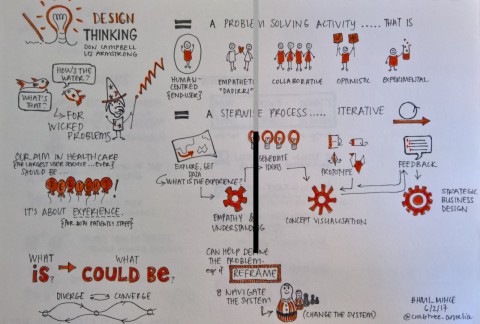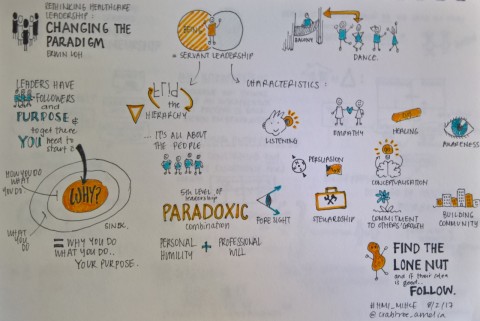During medical school, I spent hours scribing lectures, paragraphs from text books, and tutorial notes. Writing repetitively. Scraping to learn and retain every fact my brain could hold. Oh, how I wish I had known about visual note taking back then.
I discovered this form of learning support, also known as sketch-noting or info-doodling, about two years ago. During a meeting, I watched my Department Head scribble and scrawl all over a page. The upshot was a hut on an island and an isolated palm tree, which did not mean much to me, but for him it represented the essence of what was being discussed. I asked what he was doing. He told me about sketch-noting and pointed me in the direction of a couple of well-known authors in the field.
Sketch-noting is a visual method of capturing information. It is a way of connecting the dots, seeing the big picture and understanding key messages. It can support description of complex systems and facilitate problem solving. Day-to-day, I use it for learning and focus. Whether it be reading text, listening to lectures or attending conferences, creating sketch-notes has become my go-to method of recording and summarizing content. The technique can also be used for teaching. I use it to educate my patients and provide them with extra takeaways from our time together.

Sketch-noting is a verb. It’s a very active process. It starts with listening. Thinking actively about what is being conveyed and synthesis is then followed by putting something down on paper. For me that is often a word or a phrase, supported by an image. For others, the image might come first. The images might be literal or abstract. It actually doesn’t matter, so long as the resultant combination represents meaning for YOU.
It takes practice to have the individual parts of the process come together. Summarizing written text is the easiest place to start, as you can control the pace at which you receive information. I started by making notes whilst pre-reading for interactive internet-based courses. I could then further add to my notes whilst listening to the online content. Making notes whilst listening to TED talks is a great next step to hone your skill at capturing auditory information. With practice, you build up your own repertoire of images on which you can fall back when you need to complete the process faster, for example, at a conference.

People always look at my finished notes as say “Oh, I wish I could draw.” The best bit about note-taking this way is that drawing skill is not required! People don’t believe me when I say this, but take a look at my notes. A combination of simple stick figures, lines, words and the occasional learned icon can be put together by anyone. Boxes, circles, frames and arrows, combined with dot points and text can all make for notes that work. No fine art skills required. In fact, the simpler the visuals the more clarity the note can provide.

They say “a picture paints a thousand words”, but with a sketch-note the meanings of words are amplified. Add in the kinesthetic input from creating a sketch-note and you have yourself a multi-sensory way of learning. Using this technique, I find my memory for key concepts is better. Sometimes, I don’t need to refer back to my notes as the act of creating them has helped the information stick.
Keen to try it for yourself? A pen and paper is all you need.
The sketch-notes included in this blog post were all completed during the Leadership and Innovation in Health Course, a collaboration of the Harvard Macy Institute and the Monash Institute for Health and Clinical Education held in Melbourne, Australia, February 2017.
Amelia Crabtree
Dr Amelia Crabtree (MBBS, FRACP) is a Geriatrician at Alfred Health in Melbourne, Australia. Her passion for improvement and innovation is often reflected in her sketch-notes, which she posts on twitter @crabtree_amelia when she thinks they are good enough to share!

